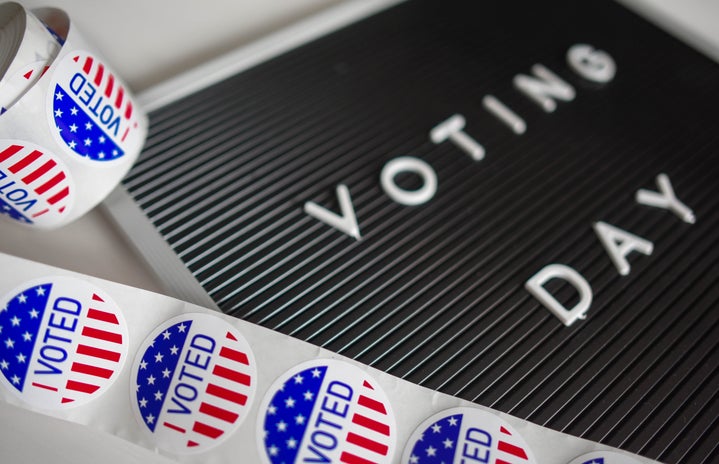When I’m curled up surrounded by half empty glasses of water (my commendable attempt at staying hydrated), and binders full of unfinished homework, my thoughts tend to wander to complex calculations of just how high I really need my GPA to be when I graduate… and the last thing on my mind? My status as a voter! Voting is something only “real” adults do, right? You know, the ones with full time jobs who have achieved all that they set out to when they were in undergrad and pondered the infamous question of “Where do you see yourself in 10 years?” Wrong. You don’t have to have it all figured out to use your voice! Most U.S. citizens, at least 18 years old on or before election day who meet their state’s residency requirements are eligible to vote! (Check with your local or state election office if you are unsure of your voter eligibility https://www.usa.gov/election-office.)
Registering to vote is easier than ever with today’s access to information and technology. Tuesday 9/24 was National Voter Registration Day, but it is never too early to register for the next round of elections. In many states, you can even pre-register as a minor! Depending on your registered address, you may be eligible to vote in State and Local elections as well as Federal Elections (Mark your calendar for the next election https://www.usa.gov/midterm-state-and-local-elections).
Don’t forget registering to vote is free, and even if you are registered you will never be required to cast a vote in any election!
To begin online registration visit https://vote.gov/.
Prefer to mail-in your ballot? Visit https://www.eac.gov/voters/national-mail-voter-registration-form/ to begin!
Face-to-Face more your style? You can find information about local locations that conduct voter registration in person (including many DMVs, Armed Forces Recruitment Centers, and Parish/County Election Offices) here at your State or Local Election Office Website: https://www.usa.gov/election-office.
For more information on your state’s requirements and available registration options visit https://www.usa.gov/register-to-vote.
So, you’re registered to vote, now what?
You can review a sample ballot (the list of candidates and proposed laws that voters mark to make choices) for your election on your State or Local Election Office Website and learn what type of voting machine you will be using at your voting location. Volunteers and Attendants at polling locations are available to explain and demonstrate the use of the voting machine if you are unsure of how to use it.
There are also a few different ways you can vote depending on your individual eligibility and residency.
If you are a student residing out of state to attend university, or unable to get to your polling place due to illness, injury, or disability you may be eligible to vote by mail-in ballot. This is called absentee voting and allows you vote in federal elections without changing your permanent address of residence, as well as vote in local and state elections based on your hometown residency even if you are not able to be there in person on election day! Visit your State or Local Election Office Website to request an absentee ballot.
You can also vote early in most states! You do not need to provide a reason for voting early, so if you have an exam or work on election day take advantage of early election periods. Check out when you can vote early in your state here: http://www.ncsl.org/research/elections-and-campaigns/early-voting-in-state-elections.aspx#Early%20Voting%20Law%20Table.
Going to the polls? Visit https://gttp.votinginfoproject.org/ and enter the address you used when you registered to vote to locate your polling location. If you are a first-time voter, and you did not register to vote in person (i.e. you registered via the mail or online) you are required to present a form of identification. Be sure to confirm with your state’s (http://www.ncsl.org/research/elections-and-campaigns/voter-id.aspx#Laws%20in%20Effect) requirements for identification, but this is usually a federal or state identification card with your photo such as driver’s license or passport.
If you do not have a valid from of ID or experience any other issues such as an incorrect spelling of your name, ask for a provisional ballot! Your provisional ballot will be set aside until your identity can be confirmed, but you will still be allowed to cast your vote.
You can always bring a friend with you to the polls! You will be separated momentarily and given privacy while you vote, but you don’t have to stand in line or check-in alone. Election day can be stressful for many individuals. Always be sure to be respectful of your friends’ privacy. Whom you vote for is a very individual and personal decision. If you would like to share your voting choices or the reasoning behind your choices with a friend it is courteous to first ask if they are open to hearing or sharing before diving into that conversation, especially if you have not discussed these topics before.
Remember, citizens of the United States are not required to register to vote or to cast a vote. Simply voting is a significant choice that you made! According to the U.S. Census Bureau only around 30% of eligible individuals 18 to 24 years old voted in the 2018 midterm election. This was the lowest percentage of any age other age group. Feel free to share a photo, wear a sticker, or speak with your family and friends. Sharing your experience can encourage and empower others in your life to use their voices too!



